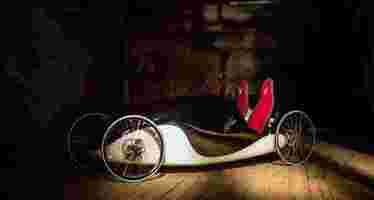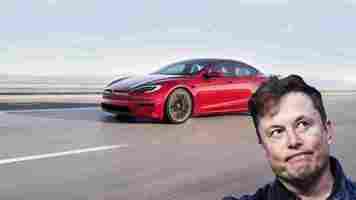Ducati won’t make electric motorcycles anytime soon
Despite teasing the idea a couple of years ago, it seems that Ducati is not going to make an all-electric motorcycle, any time soon at least.

In Motorcycle News (MCN), Ducati’s VP of Sales Francesco Milicia seemed to provide a bit more clarity on the Italian motorbike maker’s low-emission plans.
“Will we produce an electric Ducati soon? No. We think that for the kind of machine we produce now, an electric motorcycle cannot guarantee the pleasure, the range, the weight etc that Ducati riders expect,” he said.
Soon is the operative word here. The Italian marque hasn’t totally written off the idea of making an electric bike.
“We are thinking and working on electric,” Milicia told MCN. “We are part of a group that’s going quickly towards electrification and it’s a good opportunity for Ducati.”
It’s a bit complicated to go into the full details here, but in a roundabout sort of way, Ducati is owned by Audi, which is itself owned by VW. We don’t need to mention how hard those companies are looking at EVs.
Importantly for Ducati, though; Porsche, also owned by VW, is looking at synthetic fuels, and this seems to have caught the bike maker’s eye.
“We are also looking carefully at other solutions for zero or minimal emissions, such as synthetic fuel,” Milicia said. “It’s something we’re looking at in the medium term.”
Given the narrative that’s unfolding in the motorcar world, it’s surprising to see Ducati push back against the electric revolution.
Iconic brands are being forced to walk a tightrope right now, balancing their heritage and the characteristics that diehard customers know and love, whilst reinventing themselves with modern powertrains for a low emission future.
For a brand steeped in so much history and flamboyance , it’s understandable that Ducati is treading lightly as it makes its way to a low emission future.
It’s worth noting that the UK’s Triumph has just started talking up its new electric platform that’s in the making and is set to power a bunch of its vehicles.
HT – Electrek
Do EVs excite your electrons? Do ebikes get your wheels spinning? Do self-driving cars get you all charged up?
Then you need the weekly SHIFT newsletter in your life. Click here to sign up .
Could electric velomobiles change micromobility? Meet the Kinner Car
If you’re a fan of velomobiles and love the retro style, then I think you’ll find the Kinner Car intriguing — and not just because of its hybrid car-bike nature. While the Kinner is described as a primarily human-powered vehicle, you’ll still get electrical assistance.



Still a work under progress, the current prototype is 285cm long, 100cm wide, and has a 220cm wheelbase, allowing it to be legally classified as an electrically assisted bicycle — in Europe, at least.
It fits two riders and has room for luggage under the hood.
The Kinner has been created by guitar-builder and classic-vehicle-restorer Ari Jukka Luomaranta. I reached out to him, to get to know more about it.
According to Luomaranta, the Kinner will use an assistant electric motor with automatic gears.
“It’s a very innovative design,” he explains. “ The engine works like a ghost, it just feels like someone is pushing you.” It’s also designed from the user’s point of view, so the motor will keep cadence constant, without requiring any action from the rider’s part.
Plus, you can turn the Kinner “on” by simply using the respective app on your mobile.
The aim, he further notes, is to have the Kinner mostly muscle-powered. For this reason, he has focused on a lightweight design with a composite chassis and roadbike wheels.
At the same time, there are plans to develop two more variations of the vehicle: an even lighter “competitzione” model without any motor, designed for exercise and racing, and a model without pedals, solely electrically-powered.
Micromobility is booming in cities around the world, and we’re seeing more and more ebikes, escooters, tri- and quadcycles on the streets. So this made me wonder, is there a place for vehicles like the Kinner?
Luomaranta believes there will be demand for this kind of vehicle in the future.
To begin with, the Kinner encapsulates a more social concept, he says. You can ride it with a friend, a partner, a parent, you name it. Plus, it’s flexible and can easily be built in different variations to accommodate different social activities.
Luomaranta explains:
In fact, Luomaranta believes that as European cities are transforming their central areas into low-emission zones, the Kinner could provide a viable replacement to cars, by offering comfort without any environmental impact.
The first deliveries will start in April 2022 and the velomobile comes with a $17,448 price tag.
Luomaranta says that they have already received orders and that they will start making the first batch of six cars in the beginning of January.
The pedalcar will come with integrated sportwatch, navigator, and anti-theft system, but you also opt for customizable extras including windscreen, mirrors, lights and blinkers.
You can get a closer look at the Kinner on the video below:
I don’t know about you, but I’d be very interested to see velomobiles catching on, especially if they can combine modern design with a classic retro look.
California’s DMV taking Tesla to task over misleading ‘self-driving’ claims
Tesla is under review by the California Department of Motor Vehicles (DMV) to establish whether the company is using misleading advertising regarding its Full Self-Driving package, the agency told the Los Angeles Times .

State regulation prohibits advertising vehicles for sale or lease as autonomous, if they can’t comply with the regulatory definition, the DMV said.
Tesla explains on its website that both the basic Autopilot and the Full Self-Driving package don’t qualify as autonomous driving, but require “ a fully attentive driver, who has their hands on the wheel and is prepared to take over at any moment.”
Nevertheless, we can’t help but notice for the millionth time that the names of those systems are, in fact, misleading. “Autopilot” signifies an automatic driverless process, and “full self-driving capability” literally means that a vehicle is capable of driving itself. It doesn’t seem too difficult to get confused, right?
As it happens, Tesla related autonowashing instances have been occurring more often than not. Social media is bursting with videos featuring drivers defeating the driver-monitoring systems and fully relying on Autopilot to perform the ride. Just last week, a man was arrested in California for “driving” a Tesla form the back seat …
If Tesla is, indeed, found to have violated DMV’s regulations, it will face a series of penalties.
According to DMV spokesperson Anita Gore, the penalties include suspension or revocation of DMV autonomous vehicle deployment permits, and manufacturer and dealer licenses. She also added that a police officer can even remove a car from the public roadway, if it doesn’t have the respective autonomous technology permit.
The DMW will examine the following Full Self-Driving package claims:
Navigation
Auto Lane Change
Autopark
Summon
Full Self-Driving Computer
Traffic Light and Stop Sign Control
Interestingly, this isn’t the first time that Tesla has faced such allegations. Last year, a German court ruled that the company couldn’t advertise its Autopilot and Full Self-Driving products as autonomous systems in the country .
Do EVs excite your electrons? Do ebikes get your wheels spinning? Do self-driving cars get you all charged up?
Then you need the weekly SHIFT newsletter in your life. Click here to sign up .